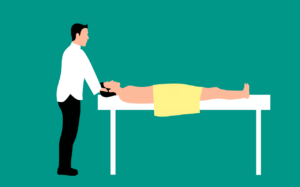
If you’ve ever experienced the discomfort of shoulder impingement, you know how it can affect your daily activities and quality of sleep. But fear not, because in this article, you will discover the best sleeping position to alleviate shoulder impingement and finally get a restful night’s sleep. With a simple adjustment in your sleep posture, you can wake up feeling refreshed and free from shoulder pain. So, let’s explore the perfect sleeping position that will give your shoulder the relief it deserves!

Understanding Shoulder Impingement
Shoulder impingement is a common condition that occurs when the tendons and bursa in the shoulder become compressed or irritated. This compression can cause pain and limited mobility in the shoulder joint. It is important to understand the causes and symptoms of shoulder impingement in order to effectively address and manage this condition.
Definition of shoulder impingement
Shoulder impingement, also known as subacromial impingement, occurs when the tendons of the rotator cuff and the subacromial bursa become trapped and compressed between the humerus (upper arm bone) and the acromion (part of the shoulder blade). This compression can lead to inflammation, pain, and limited movement in the shoulder joint. Shoulder impingement can be categorized as either primary, which occurs due to anatomical factors, or secondary, which is typically caused by overuse or trauma.
Causes of shoulder impingement
Shoulder impingement can be caused by a variety of factors. Some common causes include poor posture, repetitive overhead movements, weak shoulder muscles, trauma or injury to the shoulder, bone spurs, and age-related degeneration. Additionally, certain sports and occupations that involve repetitive shoulder movements or heavy lifting can increase the risk of developing shoulder impingement.
Symptoms of shoulder impingement
The symptoms of shoulder impingement can vary in severity and may include pain, weakness, stiffness, and limited range of motion in the affected shoulder. Individuals with shoulder impingement may experience pain or discomfort when reaching overhead, lifting heavy objects, or performing activities that require repetitive shoulder movements. It is important to seek medical attention if you experience persistent shoulder pain or if your symptoms significantly impact your daily activities.
Effect of Sleeping Position on Shoulder Impingement
Sleeping position plays a crucial role in the health of your shoulders, particularly if you are dealing with shoulder impingement. The position in which you sleep can either alleviate or exacerbate the pain and discomfort associated with this condition. Understanding the impact of sleeping position on shoulder health is essential in preventing further irritation and promoting optimal healing.
Impact of sleeping position on shoulder health
The position in which you sleep can affect the alignment of your shoulder joint and the amount of pressure placed on the tendons and bursa. Sleeping positions that involve placing excessive pressure or strain on the shoulder can lead to increased inflammation and pain. On the other hand, choosing a sleeping position that relieves pressure on the shoulder joint can help alleviate symptoms and promote healing.
Choosing the right sleeping position to relieve shoulder impingement
When it comes to sleeping with shoulder impingement, there are several positions that can provide relief. It is important to find a position that minimizes pressure on the affected shoulder while maintaining proper alignment of the spine. Let’s explore some of the best sleeping positions for shoulder impingement.

Best Sleeping Positions for Shoulder Impingement
1. Sleeping on your back
Sleeping on your back is often considered the best sleeping position for shoulder impingement. This position helps maintain proper alignment of the spine and reduces strain on the shoulder joint. Place a pillow under your knees to further support your back and relieve pressure from your shoulders.
2. Sleeping on your non-affected side
If sleeping on your back is not comfortable for you, try sleeping on your non-affected side. This position can help alleviate stress on the affected shoulder. Place a pillow between your knees to support your hips and maintain proper spinal alignment.
3. Using a pillow or cushion for support
Regardless of the sleeping position you choose, using a pillow or cushion for support can be beneficial. Place a pillow under your arm to elevate and support the affected shoulder. This can help relieve pressure and promote proper alignment during sleep.
4. Utilizing a body pillow
Using a body pillow can provide additional support and help maintain proper alignment of the spine and shoulders. Place the body pillow along your side, hugging it slightly, to prevent rolling onto your shoulder during sleep.
5. Elevating the affected arm
Elevating the affected arm can help reduce swelling and alleviate discomfort. You can achieve this by placing a pillow or cushion under your arm while in your chosen sleeping position. This will help relieve pressure on the shoulder and promote better circulation.
6. Avoiding sleeping on your stomach
Sleeping on your stomach can worsen shoulder impingement symptoms, as it places strain on the shoulder joint and compromises spinal alignment. This position should be avoided if you are experiencing shoulder impingement.
7. Using a supportive mattress and pillow
Investing in a supportive mattress and pillow can make a significant difference in your sleep quality and shoulder health. A mattress that provides adequate support and comfort will help maintain proper spinal alignment, while a pillow that properly supports your neck and head can prevent strain on your shoulders.
8. Experimenting with different positions
It is important to experiment with different sleeping positions to find the one that works best for you. Each individual’s body and level of shoulder impingement may differ, so what works for one person may not work for another. Be patient and open to trying different positions until you find the most comfortable one.
9. Seeking the advice of a healthcare professional
If you are unsure about the best sleeping position for your shoulder impingement, it is recommended to seek the advice of a healthcare professional. They can provide personalized recommendations based on your specific condition and help you find the most effective sleeping position for relieving your shoulder pain.
10. Incorporating stretches and exercises
In addition to finding the right sleeping position, incorporating stretches and exercises into your daily routine can help alleviate shoulder impingement symptoms. Consult with a healthcare professional or physical therapist to learn specific exercises and stretches that can strengthen the shoulder muscles and improve mobility.
Tips for Sleeping in the Best Position
To optimize your sleep position and effectively alleviate shoulder impingement symptoms, consider the following tips:
Maintaining proper alignment
Regardless of the sleeping position you choose, it is important to maintain proper alignment of the spine. This can be achieved by ensuring that your head, neck, and back are in a neutral position and not twisted or contorted.
Choosing the right pillow
Choosing the right pillow is essential for shoulder impingement relief. Look for a pillow that provides adequate support for your neck and head, keeping them aligned with your spine. Avoid pillows that are too high or too flat, as they can strain your neck and shoulders.
Optimizing your sleeping environment
Creating a sleep-friendly environment can greatly improve your quality of sleep. Ensure that your bedroom is dark, quiet, and at a comfortable temperature. Use blackout curtains, earplugs, and white noise machines if necessary.
Using heat or cold therapy
Applying heat or cold therapy to your shoulder before bed can help alleviate pain and reduce inflammation. Experiment with ice packs or hot water bottles to determine which therapy provides the most relief for your shoulder impingement.
Relaxation techniques and stress reduction
Stress and tension can contribute to shoulder impingement symptoms. Incorporate relaxation techniques, such as deep breathing exercises or meditation, into your bedtime routine to promote a sense of calm and relaxation.
Maintaining a consistent sleep schedule
Establishing a consistent sleep schedule can help regulate your body’s internal clock and improve your overall sleep quality. Aim to go to bed and wake up at the same time every day, even on weekends.
Preventing excessive movement during sleep
Limiting excessive movement during sleep can help prevent further irritation and strain on the shoulders. Use pillows or cushions to provide support and limit the range of motion of your arms and shoulders during sleep.
Trial and error for finding the most comfortable position
Finding the most comfortable sleeping position for shoulder impingement may require some trial and error. Be patient and willing to adjust your sleeping position and pillow arrangement until you find the arrangement that provides the most relief for your symptoms.
Listening to your body
Above all, it is important to listen to your body and respond to its needs. Pay attention to any discomfort or pain experienced during sleep and adjust your sleeping position accordingly. If a specific position exacerbates your symptoms, avoid it and try alternatives until you find the best position for you.

Preventing Shoulder Impingement
While finding the best sleeping position is crucial for managing shoulder impingement, it is equally important to take preventative measures to avoid further aggravation of the condition. Consider the following tips to prevent shoulder impingement:
Proper posture during the day
Maintaining proper posture throughout the day can help prevent shoulder impingement. Avoid slouching or rounding your shoulders, and make a conscious effort to sit or stand with your shoulder blades pulled back and down.
Regular exercise and stretching
Engaging in regular exercise and stretching can help strengthen the shoulder muscles and improve flexibility, reducing the risk of developing shoulder impingement. Focus on exercises that target the rotator cuff muscles and stretches that promote shoulder mobility.
Avoiding repetitive shoulder movements
Repetitive overhead movements, such as those often involved in sports or certain occupations, can contribute to shoulder impingement. If possible, avoid or minimize these movements and take breaks to rest and stretch your shoulders if you must engage in them.
Using proper lifting techniques
When lifting heavy objects, it is important to utilize proper lifting techniques to avoid straining your shoulders. Bend your knees, lift with your legs, and keep the load close to your body to minimize stress on your shoulders.
Strengthening the shoulder muscles
Incorporating shoulder-strengthening exercises into your fitness routine can help prevent shoulder impingement. Focus on exercises that target the rotator cuff and the muscles surrounding the shoulder joint, such as shoulder presses, lateral raises, and external rotations.
Maintaining a healthy weight
Maintaining a healthy weight is important for shoulder health. Excess weight can put additional strain on the shoulders and increase the risk of developing shoulder impingement. Follow a balanced diet and engage in regular physical activity to achieve and maintain a healthy weight.
Avoiding excessive shoulder strain
Be mindful of activities that may place excessive strain on your shoulders. Avoid lifting heavy objects or performing repetitive movements that exceed your shoulder’s capabilities. If you must engage in such activities, take breaks, use proper form, and be mindful of any warning signs of shoulder strain.
When to Consult a Healthcare Professional
While self-care measures and finding the best sleeping position can often provide relief for shoulder impingement, there are situations in which it is important to consult a healthcare professional:
Persistent shoulder pain
If your shoulder pain persists despite trying various sleeping positions and self-care techniques, it is advisable to seek medical attention. Persistent pain may indicate a more serious underlying issue that requires further investigation and treatment.
Limited shoulder range of motion
If you experience limited range of motion in your shoulder, such as being unable to lift your arm above a certain height or difficulty reaching behind your back, consult a healthcare professional. Limited range of motion may indicate a more severe case of shoulder impingement that requires professional intervention.
Redness, swelling, or warmth in the shoulder
If you notice any signs of inflammation in your shoulder, such as redness, swelling, or warmth, it is important to consult a healthcare professional. These symptoms may indicate an infection or more severe inflammation that requires medical attention.
Numbness or tingling in the arm or hand
If you experience numbness or tingling in your arm or hand, especially in combination with shoulder pain, it is essential to seek medical attention promptly. These symptoms may indicate nerve involvement or compression in the shoulder that requires immediate attention.
Difficulty sleeping due to shoulder impingement
If your shoulder impingement symptoms significantly impact your ability to sleep, it is recommended to consult a healthcare professional. They can evaluate your condition and provide guidance on the best course of treatment to alleviate your discomfort and improve your sleep quality.
Conclusion
Finding the best sleeping position for shoulder impingement is crucial for alleviating pain and promoting healing. Experiment with different positions, use pillows or cushions for support, and listen to your body to determine the most comfortable position. In addition to proper sleep positioning, practicing preventative measures and seeking medical attention when necessary can help manage shoulder impingement effectively. By incorporating stretches and exercises, maintaining good posture, and avoiding excessive strain, you can reduce the risk of developing or exacerbating shoulder impingement. Remember to consult with a healthcare professional if you experience persistent pain, limited range of motion, or other concerning symptoms associated with shoulder impingement. With the right approach, you can find relief and improve your overall shoulder health.







